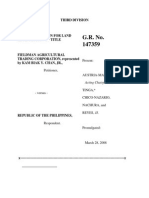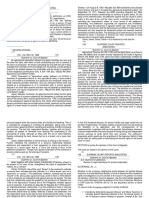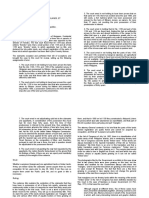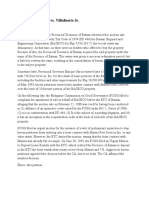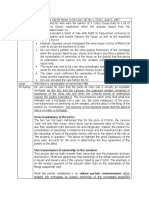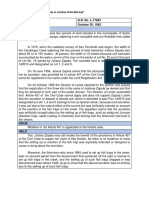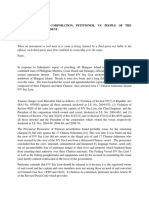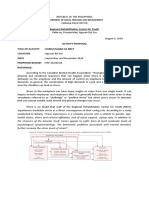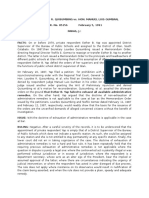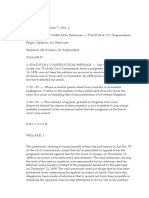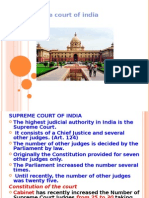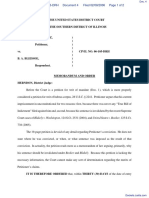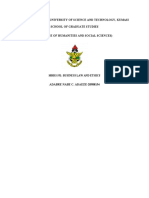Director of Lands V.S Villareal
Director of Lands V.S Villareal
Uploaded by
Mhay Khaeyl Badajos AndohuYhanCopyright:
Available Formats
Director of Lands V.S Villareal
Director of Lands V.S Villareal
Uploaded by
Mhay Khaeyl Badajos AndohuYhanOriginal Title
Copyright
Available Formats
Share this document
Did you find this document useful?
Is this content inappropriate?
Copyright:
Available Formats
Director of Lands V.S Villareal
Director of Lands V.S Villareal
Uploaded by
Mhay Khaeyl Badajos AndohuYhanCopyright:
Available Formats
MICHAEL JOHN B.
ANDOHUYAN
WEEK 5
THE DIRECTOR OF FORESTRY vs. RUPERTO VILLAREAL
G.R No. L-32266, February 27, 1989
FACTS:
On January 25, 1949, Ruperto Villareal applied for registration a 178, 118 square meters
lot. The subject lands consist mangrove swamps located in Sapian, Capiz. He alleged that he and
his predecessors-in-interest had been in possession of the land for more than forty years. He also
invoked the survey plan of the mangrove swamps approved by the Director of Lands, to prove
that the land is registerable. Some people opposed the said application including the petitioner
representing the Republic of the Philippines. However, after the trial the court approved its
application and was affirmed by the Court of Appeals.
The Director of Forestry then went to the Supreme Court in a petition for review
on certiorari claiming that the land in dispute was forestal in nature and not subject to private
appropriation. He asks that the registration be reversed. He also contended that land under
dispute being admittedly a part of the mangrove swamps of Sapian, and for which a minor forest
license had in fact been issued by the Bureau of Forestry from 1920 to 1950, it must be
considered forest land. Hence, not alienable or open to disposition contrary to the contention of
Villareal.
ISSUE:
Whether or not mangrove swamps, or manglares are part of agricultural or public forest
lands and open for disposition?
RULING:
No, the subject land is not open for disposition and alienable. Mangrove swamps
or manglares should be understood as comprised within the public forests of the Philippines as
defined in Section 1820 of the Administrative Code of 1917. forest' includes, except as otherwise
specially indicated, all unreserved public land, including nipa and mangrove swamps, and all
forest reserves of whatever character. Swampy areas covered by mangrove trees, nipa palms,
and other trees growing in brackish or sea water may also be classified as forest land.
The contention of the respondent on the existence of a plan is incorrect because its mere
existence would not have the effect of converting the mangrove swamps, as forest land, into
agricultural land. To be so, it had first to be released as forest land and reclassified as agricultural
land pursuant to the certification the Director of Forestry may issue under Section 1827 of the
Revised Administrative Code.
The tax declarations made by the private respondent were practically the only basis used
by the appellate court in sustaining his claim of possession over the land in question. Tax
declarations are not sufficient to prove possession and much less vest ownership in favor of the
declarant as held in countless cases.
Hence, it is clear that the subject land is not alienable under the Constitution and may not
be the subject of private ownership until and unless they are first released as forest land and
classified as alienable agricultural land. The decision of the CA is set aside and the application for
title thereof is dismissed.
You might also like
- Land Titles and DeedsDocument2 pagesLand Titles and DeedsReihannah Paguital-MagnoNo ratings yet
- NVC Proposal SampleDocument3 pagesNVC Proposal SampleMhay Khaeyl Badajos AndohuYhanNo ratings yet
- Facts:: Director of Forestry v. Villareal, GR No. 32266, February 27, 1989Document3 pagesFacts:: Director of Forestry v. Villareal, GR No. 32266, February 27, 1989Al Jay MejosNo ratings yet
- Ayog vs. CusiDocument21 pagesAyog vs. CusiSayeret MatkalNo ratings yet
- Director of Forestry Vs Villareal GR No. L-32266 Feb 27,1989 DIGESTEDDocument1 pageDirector of Forestry Vs Villareal GR No. L-32266 Feb 27,1989 DIGESTEDJacquelyn AlegriaNo ratings yet
- Fieldman Trading Corp. vs. RP, GR No. 147359, March 28, 2008 ORIGINALDocument17 pagesFieldman Trading Corp. vs. RP, GR No. 147359, March 28, 2008 ORIGINALJacquelyn AlegriaNo ratings yet
- The Director of Forestry, Petitioner RUPERTO A. VILLAREAL, RespondentDocument22 pagesThe Director of Forestry, Petitioner RUPERTO A. VILLAREAL, RespondentHiedi SugamotoNo ratings yet
- Mustang Lumber V. Ca: IssueDocument45 pagesMustang Lumber V. Ca: IssueJoshua ParilNo ratings yet
- Guerrero Vs CADocument6 pagesGuerrero Vs CAMichelle Marie TablizoNo ratings yet
- Case No. 3 Secretary of DENR Vs Yap G.R. No. 167707 & 173775 FactsDocument3 pagesCase No. 3 Secretary of DENR Vs Yap G.R. No. 167707 & 173775 FactsEi Ar TaradjiNo ratings yet
- Regional Trial Court - CaptionDocument1 pageRegional Trial Court - CaptionIra Comia SoguilonNo ratings yet
- Jocson V Director of Forestry GR L-13756Document3 pagesJocson V Director of Forestry GR L-13756MichaelaNo ratings yet
- Locsin Vs Climaco Case DigestDocument1 pageLocsin Vs Climaco Case DigestLucky VastardNo ratings yet
- Spouses Cayetano and Tiongson v. CADocument3 pagesSpouses Cayetano and Tiongson v. CAangelo prietoNo ratings yet
- Bayasen Vs CADocument1 pageBayasen Vs CAKokoNo ratings yet
- G.R. No. 183589 June 25, 2014 Charlie Lim vs. Spouses Danilo Ligon and Generosa Vitug-LigonDocument13 pagesG.R. No. 183589 June 25, 2014 Charlie Lim vs. Spouses Danilo Ligon and Generosa Vitug-LigondaryllNo ratings yet
- REPUBLIC vs. CA MARCELO and HEIRS OF ZURBITODocument1 pageREPUBLIC vs. CA MARCELO and HEIRS OF ZURBITONanely EjasNo ratings yet
- Roxas Vs EnriquezDocument1 pageRoxas Vs EnriquezShammah Rey Mahinay100% (1)
- Tiongco Vs Director of LandsDocument2 pagesTiongco Vs Director of LandsDatu TahilNo ratings yet
- 3 - Ba Vs GustiloDocument7 pages3 - Ba Vs Gustilodeuce scriNo ratings yet
- Heirs of Emiliano NavarroDocument2 pagesHeirs of Emiliano NavarroAly ConcepcionNo ratings yet
- Digest-Metro Transit vs. NLRCDocument2 pagesDigest-Metro Transit vs. NLRCjovani emaNo ratings yet
- Concept of Jura RegaliaDocument4 pagesConcept of Jura RegaliaKenneth AbuanNo ratings yet
- Bishop of Calbayog vs. Municipality of Catarman and Director of LandsDocument1 pageBishop of Calbayog vs. Municipality of Catarman and Director of LandswupwupwupNo ratings yet
- Add CasesDocument4 pagesAdd CasesWilfredo Guerrero IIINo ratings yet
- Nicaragua V Colombia: A Stalemate at The CaribbeanDocument10 pagesNicaragua V Colombia: A Stalemate at The CaribbeanDiego Ignacio Jiménez CabreraNo ratings yet
- Caviles, Jr. v. Bautista, GR 102648, Nov. 24, 1999, 319 SCRA 24Document1 pageCaviles, Jr. v. Bautista, GR 102648, Nov. 24, 1999, 319 SCRA 24Gia DimayugaNo ratings yet
- Gonzales Vs CTADocument6 pagesGonzales Vs CTAEANo ratings yet
- Ankron Vs GovernmentDocument1 pageAnkron Vs GovernmentValerie FojaNo ratings yet
- G.R. No. 176492 October 20, 2014 MARIETTA N. BARRIDO, Petitioner, LEONARDO V. NONATO, RespondentDocument3 pagesG.R. No. 176492 October 20, 2014 MARIETTA N. BARRIDO, Petitioner, LEONARDO V. NONATO, RespondentLiza MarieNo ratings yet
- Republic Vs Register of Deeds Quezon (1995)Document1 pageRepublic Vs Register of Deeds Quezon (1995)JOFAMIL SEVILLENONo ratings yet
- Sonza v. ABS-CBNDocument4 pagesSonza v. ABS-CBNLoreen DanaoNo ratings yet
- 76 Sonza v. ABS-CBN Broadcasting Corp., 431 SCRA 583Document10 pages76 Sonza v. ABS-CBN Broadcasting Corp., 431 SCRA 583Andrei Da JoseNo ratings yet
- Province of Bataan Vs Villafuerte Jr.Document2 pagesProvince of Bataan Vs Villafuerte Jr.Dennis Jay Dencio Paras0% (1)
- Assignment-Property-Case DigestDocument7 pagesAssignment-Property-Case DigestKeziah Eldene VilloraNo ratings yet
- Pnoc-Energy Development Corporation (Pnoc-Edc), Vs - Emiliano G. Veneracion, JR., G.R. No. 129820 November 30, 2006Document3 pagesPnoc-Energy Development Corporation (Pnoc-Edc), Vs - Emiliano G. Veneracion, JR., G.R. No. 129820 November 30, 2006Gabby ElardoNo ratings yet
- CDC Vs MateoDocument1 pageCDC Vs MateoVanya Klarika NuqueNo ratings yet
- Republic vs. RanesesDocument2 pagesRepublic vs. RanesesEl SitasNo ratings yet
- Obillos Vs CIRDocument2 pagesObillos Vs CIRGeorge HabaconNo ratings yet
- 26 - Heirs of Grino v. DARDocument1 page26 - Heirs of Grino v. DAReieipayadNo ratings yet
- 1st - Pagkatipunan X RanesesDocument5 pages1st - Pagkatipunan X RanesesCelestino LawNo ratings yet
- 3admin - 9Document4 pages3admin - 9JMXNo ratings yet
- Telecom V ComelecDocument1 pageTelecom V Comelecdwight yuNo ratings yet
- Canonizado V Aguirre CaseDocument10 pagesCanonizado V Aguirre CaseJoshua LanzonNo ratings yet
- Agro Industries Vs CADocument2 pagesAgro Industries Vs CAczeskajohann100% (1)
- 7 Junio v. Garilao DigestDocument3 pages7 Junio v. Garilao DigestJaysieMicabaloNo ratings yet
- Santos V MorenoDocument5 pagesSantos V MorenoeieipayadNo ratings yet
- TAXATION 1 - Hopewell Power V CommissionerDocument3 pagesTAXATION 1 - Hopewell Power V CommissionerSuiNo ratings yet
- Digest Pool 1Document25 pagesDigest Pool 1Ralph HonoricoNo ratings yet
- Director of Lands Vs CA, G - R - No - L-58867, June 22, 1984, 129 SCRA 689Document2 pagesDirector of Lands Vs CA, G - R - No - L-58867, June 22, 1984, 129 SCRA 689ben carlo ramos srNo ratings yet
- 201 - Maria Bautista Vda de Reyes Vs de Leon (June 6, 1967)Document2 pages201 - Maria Bautista Vda de Reyes Vs de Leon (June 6, 1967)Carie LawyerrNo ratings yet
- 8 Zapata V Director of LandsDocument1 page8 Zapata V Director of LandsVal SanchezNo ratings yet
- Rule 12 Sea Lion Fishing Corporation V PeopleDocument2 pagesRule 12 Sea Lion Fishing Corporation V PeoplemrpowerplusNo ratings yet
- LTD Set 2 4. REPUBLIC Vs ZURBARAN REALTYDocument1 pageLTD Set 2 4. REPUBLIC Vs ZURBARAN REALTYhully gullyNo ratings yet
- Director of Lands vs. Register of Deeds of RizalDocument2 pagesDirector of Lands vs. Register of Deeds of RizalMay RMNo ratings yet
- 17 Lastimoza v. BlancoDocument1 page17 Lastimoza v. BlancoRem SerranoNo ratings yet
- Republic v. Guerrero Temanel, XyDocument3 pagesRepublic v. Guerrero Temanel, XyEPZ RELANo ratings yet
- Siain Enterpresis Vs Cupertino Realty Corp and Edwin R CatacutanDocument3 pagesSiain Enterpresis Vs Cupertino Realty Corp and Edwin R CatacutankarlNo ratings yet
- Week 6 - 7Document7 pagesWeek 6 - 7Juris MendozaNo ratings yet
- NatRes Digested CaseDocument2 pagesNatRes Digested CaseJeng GacalNo ratings yet
- G.R. No. L-32266 February 27, 1989 The Director of Forestry, Petitioner vs. RUPERTO A. VILLAREAL, Respondent FactsDocument1 pageG.R. No. L-32266 February 27, 1989 The Director of Forestry, Petitioner vs. RUPERTO A. VILLAREAL, Respondent FactsTricia SibalNo ratings yet
- Presentation Working With IndividualsDocument144 pagesPresentation Working With IndividualsMhay Khaeyl Badajos AndohuYhanNo ratings yet
- Case of MaricelDocument2 pagesCase of MaricelMhay Khaeyl Badajos AndohuYhanNo ratings yet
- Aiza A. Cabrera, RSW: Planning Officer Policy and Planning DivisionDocument7 pagesAiza A. Cabrera, RSW: Planning Officer Policy and Planning DivisionMhay Khaeyl Badajos AndohuYhanNo ratings yet
- Regional Rehabilitation Center For Youth (Rrcy)Document22 pagesRegional Rehabilitation Center For Youth (Rrcy)Mhay Khaeyl Badajos AndohuYhanNo ratings yet
- Regional Rehabilitation Center For Youth (Rrcy) : 2018 1 Semester Accomplishment ReportDocument16 pagesRegional Rehabilitation Center For Youth (Rrcy) : 2018 1 Semester Accomplishment ReportMhay Khaeyl Badajos AndohuYhanNo ratings yet
- Regional Rehabilitation Center For Youth (Rrcy) : 2019 Accomplishment ReportDocument26 pagesRegional Rehabilitation Center For Youth (Rrcy) : 2019 Accomplishment ReportMhay Khaeyl Badajos AndohuYhanNo ratings yet
- Kumustahan Sa RRCY RevisedDocument4 pagesKumustahan Sa RRCY RevisedMhay Khaeyl Badajos AndohuYhanNo ratings yet
- People Vs Rodriguez (135 SCRA 485) DigestDocument1 pagePeople Vs Rodriguez (135 SCRA 485) DigestMhay Khaeyl Badajos AndohuYhan100% (2)
- People v. BurgosDocument1 pagePeople v. BurgosMhay Khaeyl Badajos AndohuYhanNo ratings yet
- People Vs HindoyDocument2 pagesPeople Vs HindoyMhay Khaeyl Badajos AndohuYhanNo ratings yet
- Gunabe Vs Director of PrisonsDocument1 pageGunabe Vs Director of PrisonsMhay Khaeyl Badajos AndohuYhanNo ratings yet
- GR Nos 153524-25 Soria VS DesiertoDocument3 pagesGR Nos 153524-25 Soria VS DesiertoMhay Khaeyl Badajos AndohuYhan100% (1)
- PEOPLE Vs ANGELESDocument1 pagePEOPLE Vs ANGELESMhay Khaeyl Badajos AndohuYhanNo ratings yet
- Laurel vs. MisaDocument2 pagesLaurel vs. MisaMhay Khaeyl Badajos AndohuYhanNo ratings yet
- CONST1 Judicial Revew Cases Atty. LozareDocument4 pagesCONST1 Judicial Revew Cases Atty. LozareMhay Khaeyl Badajos AndohuYhanNo ratings yet
- Case SummaryDocument2 pagesCase SummaryNevadaGadflyNo ratings yet
- Ballard v. FBI, 4th Cir. (2004)Document3 pagesBallard v. FBI, 4th Cir. (2004)Scribd Government DocsNo ratings yet
- United States v. Amos Brown, A/K/A Nabb Ali, 859 F.2d 150, 4th Cir. (1988)Document3 pagesUnited States v. Amos Brown, A/K/A Nabb Ali, 859 F.2d 150, 4th Cir. (1988)Scribd Government DocsNo ratings yet
- Prudential Bank Vs CastroDocument2 pagesPrudential Bank Vs CastroCarlota Nicolas VillaromanNo ratings yet
- United States v. John Joseph Chodor, 479 F.2d 661, 1st Cir. (1973)Document4 pagesUnited States v. John Joseph Chodor, 479 F.2d 661, 1st Cir. (1973)Scribd Government DocsNo ratings yet
- Ligtas Vs PeopleDocument3 pagesLigtas Vs PeopleGeorge AlmedaNo ratings yet
- Ramirez V Elomina - REMDocument2 pagesRamirez V Elomina - REMmaiah1981No ratings yet
- Central Administrative Tribunal Ahmedabad Bench, Ahmedabad. OA No.169/2019 With MA No. 174/2019 This The 01 Day of May, 2019Document4 pagesCentral Administrative Tribunal Ahmedabad Bench, Ahmedabad. OA No.169/2019 With MA No. 174/2019 This The 01 Day of May, 2019Kishan TilavatNo ratings yet
- Quisumbing vs. GumbanDocument2 pagesQuisumbing vs. GumbanXyra Krezel Gajete100% (1)
- Dominga Palacat vs. Heirs of Florentino HontanosasDocument2 pagesDominga Palacat vs. Heirs of Florentino HontanosasMark Dennis AsuncionNo ratings yet
- JOSE EMETERIO GUEVARA, Petitioner, v. TUASON & CO., Respondents.Document3 pagesJOSE EMETERIO GUEVARA, Petitioner, v. TUASON & CO., Respondents.THERESE ZSA TORRESNo ratings yet
- WHYMS v. HSBC BANK USA, NATIONAL ASSOCIATION FOR THE BENEFIT OF ACE SECURITIES CORP. DocketDocument2 pagesWHYMS v. HSBC BANK USA, NATIONAL ASSOCIATION FOR THE BENEFIT OF ACE SECURITIES CORP. DocketACELitigationWatchNo ratings yet
- Manila Trading & Supply Co. v. Zulueta,, 69 Phil 485-487Document3 pagesManila Trading & Supply Co. v. Zulueta,, 69 Phil 485-487Kathryn Nyth KirklandNo ratings yet
- Hendricks v. Workman, 10th Cir. (2005)Document3 pagesHendricks v. Workman, 10th Cir. (2005)Scribd Government DocsNo ratings yet
- The Courts of Ontario FlowchartDocument1 pageThe Courts of Ontario Flowchartapi-241505258No ratings yet
- Reference (Section 113)Document5 pagesReference (Section 113)Sahana MathpatiNo ratings yet
- Union Judiciary 1233676269748774 1Document20 pagesUnion Judiciary 1233676269748774 1kaustubh88No ratings yet
- Republic of Kenya in The Hich Court at Homabay HCCA NO.116 OF 2021Document4 pagesRepublic of Kenya in The Hich Court at Homabay HCCA NO.116 OF 2021Wakili Oduor OgingaNo ratings yet
- The Judicature and Application of Laws (Criminal Appeals and Revisions in Proceedings Originating From Primary Courts) Rules, 2021Document8 pagesThe Judicature and Application of Laws (Criminal Appeals and Revisions in Proceedings Originating From Primary Courts) Rules, 2021John KimbariNo ratings yet
- OCA Circular No. 107-2024Document3 pagesOCA Circular No. 107-2024eneirraNo ratings yet
- Recommendation Letter With Conforme Preferencing - 6-27-24Document2 pagesRecommendation Letter With Conforme Preferencing - 6-27-24tomolnocericksonNo ratings yet
- Bail Before High Court Under Section 439, CRPCDocument2 pagesBail Before High Court Under Section 439, CRPCJJ JanardhanNo ratings yet
- PEOPLE OF THE PHILIPPINES V HON MACEDADocument2 pagesPEOPLE OF THE PHILIPPINES V HON MACEDAMigz OrtiagaNo ratings yet
- First Instance and Appellate Courts ExamplesDocument2 pagesFirst Instance and Appellate Courts ExamplesSumukhan LoganathanNo ratings yet
- Aaron Jacob Greenspan Sues and Looses Against The Administrative CourtsDocument2 pagesAaron Jacob Greenspan Sues and Looses Against The Administrative Courtsolga vosNo ratings yet
- Velasquez v. Bledsoe - Document No. 4Document2 pagesVelasquez v. Bledsoe - Document No. 4Justia.comNo ratings yet
- LaRace V WF Remval Fed Docket 3 - 12 CV 11545 MAP 2012Document6 pagesLaRace V WF Remval Fed Docket 3 - 12 CV 11545 MAP 2012RussinatorNo ratings yet
- Bradford Wedra v. Eugene S. Lefevre, Warden, Clinton Correctional Facility, 988 F.2d 334, 2d Cir. (1993)Document15 pagesBradford Wedra v. Eugene S. Lefevre, Warden, Clinton Correctional Facility, 988 F.2d 334, 2d Cir. (1993)Scribd Government DocsNo ratings yet
- Final Law AssignmentDocument17 pagesFinal Law AssignmentAdabre AdaezeNo ratings yet
- Plaintiff-Appellee Vs Vs Defendants-Appellants Pablo C. Añosa Leon O. Ty Ladislao L. Reyes, Emilio Benitez, Jr. V. G. MontesDocument6 pagesPlaintiff-Appellee Vs Vs Defendants-Appellants Pablo C. Añosa Leon O. Ty Ladislao L. Reyes, Emilio Benitez, Jr. V. G. MontesKristinaCastellanoNo ratings yet





